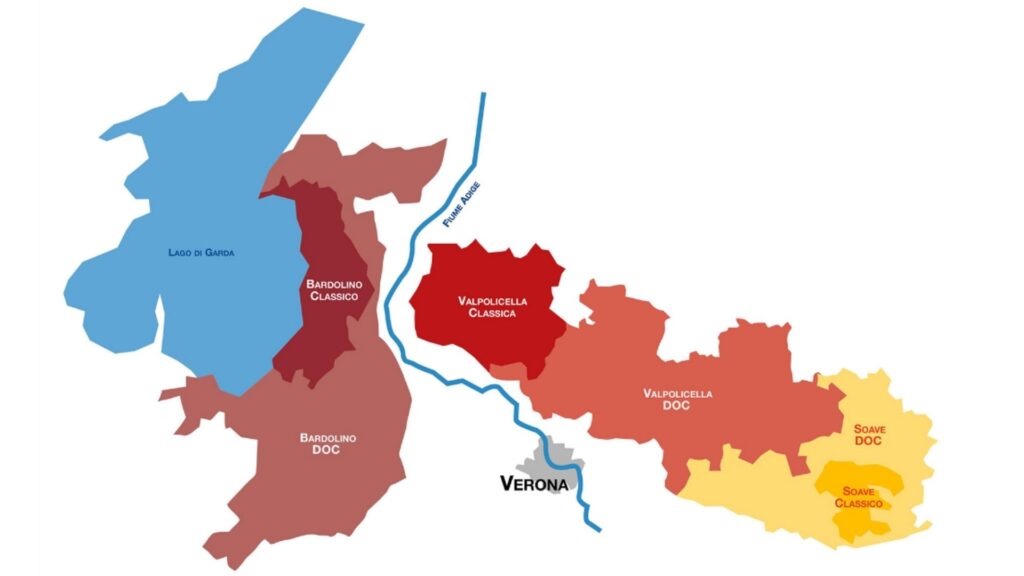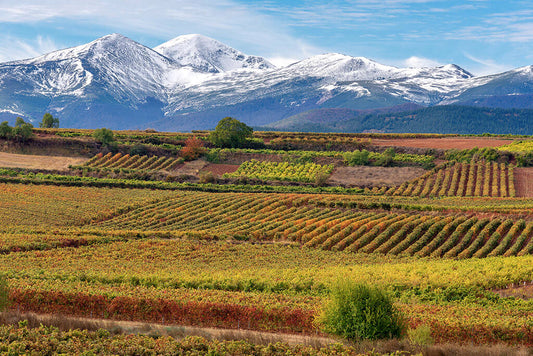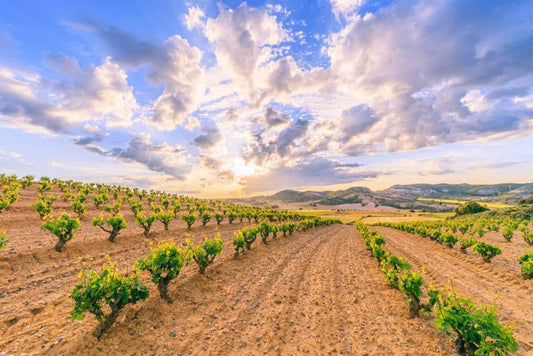With its magnificent landscapes as well as its rich cultural and gastronomic heritage, Italy never ceases to fascinate. If you are a lover of red wines, it is therefore impossible for you to miss those from the Valpolicella region, a Veneto region particularly recognized for its elegant and expressive wines.
Let's set sail for northern Italy and explore Valpolicella and its vineyards, from their origins to where they are today. Buon viaggio!
Summary
History and origins of Valpolicella wines
Located in Veneto, around the town of Verona, Valpolicella is a historic wine region of Italy. The first traces of viticulture here date back to Antiquity, where archaeological evidence (amphorae) confirm that the Romans were already producing wine here. The name "Valpolicella" comes from the Latin "Vallis Pulicella," meaning "valley of small vines." Poetic, isn’t it ?
The Romans greatly appreciated the wines of this region, which were also exported to other parts of the Empire.
Then, in the Middle Ages, the monasteries played a crucial role in the development of viticulture in the region. During this long period, the quality of the wines has greatly improved.
The period of the Renaissance saw an increase in interest in Valpolicella wines, with several historical documents mentioning their high quality. The wine trade then developed strongly in the region, the latter exporting its wines to other regions of Italy and beyond.
At the end of the 19th century, the phylloxera crisis seriously affected viticulture throughout Europe. Valpolicella was not spared and a large part of its vines had to be uprooted. However, although it took several decades, the vineyard was gradually replanted thanks to the know-how and tenacity of local winegrowers.
In 20th century, Italy began to establish strict regulations on its wines, leading in 1968 to the official creation of the appellation Valpolicella DOC (Denominazione di Origine Controllata), thus defining winemaking practices, yield limits as well as authorized grape varieties.
Today, the Valpolicella vineyard extends over 7,000 hectares and produces only red wines. The vintages produced have very varied aromatic profiles and several appellations (which we will discuss) coexist within the region.

Map of appellations of the region of Veneto
Climates and soils of the Valpolicella region
The Valpolicella DOC benefits from a unique natural environment, influenced by several geographical elements.The nearby Lake Gardaacts as a real climate regulator. Its temperate waters help to soften temperatures, particularly during the cooler months, and allow the vines to benefit from a favorable microclimate throughout the year.
This temperate climate, combined with gentle winds from the Lessini Mountains and the Dolomites, create ideal conditions for viticulture.
The region also presents a wide variety of sedimentary soils, mainly clay-limestone, but also with a notable presence of sand. This unique combination of minerals provides excellent drainage to the vine while retaining essential nutrients.
Another important criterion of the vineyard is its altitude. The Valpolicella vines extend from 70m to 450m in height, allowing them to benefit from a beautiful thermal amplitude between day and night. This factor greatly favors the aromatic complexity of the grapes.
Finally, another striking aspect of the Valpolicella terroir is the role of the winds. Here, Bora and Sirocco help to reduce ambient humidity , thus tempering the potential development of certain diseases.

Vineyard within the DOC Valpolicella
Valpolicella wines
Several appellations exist within the Valpolicella region. However, the wines bearing the name "Valpolicella" are all red and made from a unique blend of local grape varieties.
Corvina (around 50% of the vineyard) plays an essential role here and is accompanied by the varieties Rondinella (around 25%) and Molinara (a little more than 5%). Several other grape varieties such as Forselina, Negrara and Oseleta are also authorized but in small percentages.
All these red grape varieties are appreciated for their ability to produce wines with very diverse styles, ranging from light and fruity vintages to powerful and complex great wines, all depending on the style of winemaking used by the winegrower.
But then, what exactly are the different types of Valpolicella that you can taste ?
Valpolicella DOC & Valpolicella Classico DOC
The Valpolicella DOC mainly produces dry red wines focused on fruit and lightness.
A light ruby color here gives off notes of fresh cherry, raspberry, strawberry and even violet. The acidity is very pleasant, making this type of wine fragrant and easy to drink.
Certain wines may also bear the appellation Valpolicella Classico DOC, meaning that the latter come from vines located in the historic heart of the vineyard, this that is to say between the villages of Negrar, Marano, Fumane, Sant'Ambrogio, and San Pietro in Cariano. The vines here generally benefit from better climatic conditions and terroirs renowned for producing superior quality wines.
Finally, the reference “Superiore ” guarantees you a Valpolicella (Classico or not) with more structure, a higher alcohol content as well as 'minimum aging of one year.
All these wines are best enjoyed at a serving temperature around 14-16°C.
Valpolicella Ripasso DOC
The particularity of the wines bearing this appellation lies in their process of secondary fermentation.
A “ classic ” wine is produced here then put back into contact with the berries used to produce Amarone or Recioto (see continuation of the article ), still impregnated with sugars and aromatic compounds. This "ironing" (ripasso) then enriches the wine in flavors and structure, offering notes of black cherry, plum, dried fig or even chocolate and tobacco.
Valpolicella Ripasso is therefore richer and more full-bodied than classic Valpolicella, but also has soft tannins and well-balanced acidity. It is recommended to serve this type of vintage at a temperature around 16-18°C.
Amarone della Valpolicella DOCG
Amarone della Valpolicella is undoubtedly the most prestigious wine of the region. This red wine is produced using a grape drying method, called « appassimento ».
After harvest (generally late enough to promote high maturity), the grape bunches are then placed in boxes in a ventilated room in order to dehydrate them. This process, generally lasting between 3 and 4 months, has the effect of concentrating the berries in sugars and aromas. Then, the grapes are pressed, and the must is fermented, thus creating a very powerful, alcoholic and complex wine.
Amarone indeed offers a range of particularly rich and intense aromas. Very ripe black fruits (black cherry, blackberry, plum) sit alongside notes of dried fruits (figs, raisins), as well as aromas of cocoa, licorice, tobacco and leather. With age, Amarone develops aromas of prunes, truffle, and coffee.
In the mouth, the texture of Amarone is velvety and, although the tannins are present, the latter are rather silky. Finally, although a certain sweetness can be felt when tasting, a nice acidity is generally present, allowing all this power to be balanced.
Amarone is resolutely a great red wine for keeping, capable of aging for several decades. This therefore requires service at a temperature between 16-18°C.

Recioto della Valpolicella DOCG
Recioto della Valpolicella is a sweet red wine emblematic of the region.
Here, the vinification process is the same as Amarone (drying the bunches on racks), with the difference that the grapes must lose at least 50% of their weight before they can be vinified. For Amarone, the loss is "only" 30 to 40%.
Another notable difference, fermentation is stopped here in order to preserve part of the sugars, therefore giving a sweet wine.
Note that Recioto is the ancestor of Amarone ! As global demand has in fact evolved towards a greater appetite for dry wines (without sugar), winegrowers have had to adapt and today produce more Amarone than Recioto.
From an aromatic point of view, Recioto offers notes of dried fruits, chocolate, cherry and spices. Its sweetness is well balanced by a refreshing acidity. The last is generally used at a temperature between 14 and 16°C.
What to eat with Valpolicella wines ?
Now that you know the different wines of the region, let's sit down and discover some examples of dishes with which you can enjoy each of these wines.
With the “ classic ” wines of Valpolicella
The wines of the DOC Valpolicella & Valpolicella Classico are perfect for aperitifs. Their freshness and light fruitiness will pair wonderfully with bruschettas garnished with tomatoes and olive oil, or even with a delicious charcuterie board.
marinated olives, soft cheeses or even tapenade toast are also good choices to accompany this type of wine.
With a Valpolicella Ripasso
Thanks to its texture and smoothness, Valpolicella Ripasso requires more structured dishes. For example, it will pair ideally with a porcini mushroom risotto or with meat dishes in sauce such as osso bucco or even with eggplant alla Parmigiana.
white meats (chicken, veal, turkey, pork, etc.), if well seasoned, also go well with Valpolicella Ripasso.
With an Amarone della Valpolicella
The power and aromatic intensity of an Amarone almost necessarily suggests red meat. Rare steak with pepper sauce, game, beef stew or leg of lamb will enhance this great nectar.
More surprising, the sensation of sweetness that Amarone generally leaves in the mouth allows it to be deliciously combined with chocolate desserts ! Try a chocolate cake or a tiramisu if you don't believe me !

What's better than an Amarone della Valpolicella to enhance a rare steak ?
With a Recioto della Valpolicella
Recioto della Valpolicella, with its sweetness and richness, is mainly intended for dessert. Chocolate cakes, truffles or fondants perfectly complement the sweetness of this wine. Fruit desserts like cherry tarts or raspberry tarts are also great pairings, as are dried fruits.
Finally, Recioto can also be combined gracefully with ripened cheeses such as gorgonzola or parmesan.
The best wines of Valpolicella
There are many vineyards in the Valpolicella region.
This small family property of 4 hectares located in the historic heart of the vineyard is indeed recognized for its high quality wines.Although not officially certified, the vineyard is also masterfully managed using techniques very close to organic farming.
Go and discover their Valpo’ classico or their Amarone, let me know what you're up to !
I hope this article has made you want to dive into the fascinating world of Valpolicella wines! So continue the experience by visiting our site







